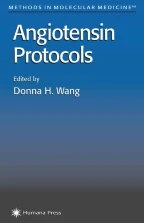
Characterization and cloning of the AT1 and AT2 receptors would not have been possible without an assay that could detect and measure the density and affinity of these receptors. The most frequently used, if not the only, methodological approach used to investigate these receptors is the radioligand binding assay performed either in a test tube with tissue-membrane preparations or cultured cells, or on tissue sections (the latter revealed by autoradiography). This chapter will only deal with the test-tube radioligand binding assay. In this assay, a radiolabeled ligand (labeled with 125 I or 3 H, for example) is incubated with a membrane preparation or cells in presence of receptor subtype-specific antagonist or agonist. After reaching equilibrium, the receptor-bound tracer is separated from the free tracer by rapid filtration through glass fiber filters or by centrifugation. The amount (cpm) of bound tracer is then used to calculate the density and affinity of each receptor subtype. Alternatively, other experiments can be designed to derive kinetics of association and dissociation or saturation.
This is a preview of subscription content, log in via an institution to check access.